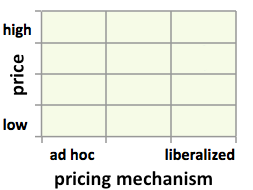Fuel Prices Ghana
Part of: GIZ International Fuel Price database
Also see: Ghana Energy Situation
Fuel Pricing Policies
| Local Currency: | GHS |
| Exchange Rate: | 1.4183
|
| Last Update: |
"Pricing policy: Ghana liberalized fuel prices in Feb 2005 and began setting price ceilings in line with world prices. A 2005 law establishing the National Petroleum Authority (NPA) also established the Unified Petroleum Price Fund (UPPF) to equalize transport costs. A UPPF levy is imposed on each fuel, about US$0.03/liter in Feb 2013. The ex-refinery differential, which operates like a price stabilization fund, was introduced in the last quarter of 2006 to pay fuel marketers for under-recovery of costs for selling kerosene, LPG, and premix. Government began reviewing prices twice a month in Oct 2007, but suspended price adjustments between May and Nov 2008. The frequency of price adjustments fell sharply beginning in 2009. There was a 30% price increase in Jun 2009. There were no price adjustments in 2010, two price increases in 2011, and one downward price adjustment in 2012, with several of these adjustments tending to be large. KeroseneIn Feb 2013, prices havewere raised by between 15% (kerosene, the price of which had been frozen since end of Oct 2009. and 50% (LPG). The price of pre-mix was not adjusted, widening the price difference between gasoline and pre-mix to a factor of nearly 4. A cross-subsidy levy is charged on each fuel, with gasoline contributing to the cross-subsidy and all other fuels benefiting from it. The price ceilings for diesel and monthly average benchmark FOB prices relevant to Ghana since 2007 are shown below. The plot shows that the frequency of price adjustments has fallen sharply in recent years. The bulk of the subsidy is provided not by the cross-subsidy levy but at the point of setting the ex-refinery price. In Nov 2011, the ex-refinery price differential was declared illegal, and the stay of execution was denied in Jan 2012. Premix (gasoline mixed with lubricant) is used in fishing boats and heavily subsidized, priced at less than one third of gasoline since Dec 2011. In Feb 2013, NPA called on government to eliminate subsidies by Dec 2013.
Protests: A price increase of 30% for gasoline and diesel in Jan 2011 sparked street protests in Accra.
Consequences of subsidies: NPA said in Feb 2012 that the fuel subsidy in 2011 was in excess of 450 million cedis (US$276 million). There have been fraudulent claims against UPPF of products being delivered to remote areas when they were actually delivered to major consumption centers in urban areas. LPG subsidies have led to soaring consumption of automotive LPG, causing shortages and prompting commercial LPG vehicle drivers to ask government for subsidy removal so as to ensure reliable supply.
Hedging: Ghana’s cabinet in Mar 2010 approved a Commodity Price Risk Management Policy, paving the way for hedging petroleum products and crude oil. Ghana hedged half of its crude oil requirements in 2010−11. In Jun 2011, the finance minister announced that government would hedge 100% of crude output and about half of crude purchase. IMF reported in Feb 2012 that sizable hedging gains in the first half of 2011 allowed fuel subsidies to be covered through July. In Jan 2012, government announced that it was hedging crude on a quarterly basis.
Information: NPA posts detailed information on current and historical prices and price structures on its Web site, although subsidies at the refinery gate are not made explicit."
(Source: Kojima, Masami. (2013, forthcoming). “Petroleum product pricing and complementary policies:Experience of 65 developing countries since 2009.” Washington DC: World Bank.)
Fuel Prices and Trends
| Gasoline 95 Octane | Diesel | |
|---|---|---|
| in USD* |
|
|
| in Local Currency |
|
|
* benchmark lines: green=US price; grey=price in Spain; red=price of Crude Oil
Fuel Price Composition
Price composition for one litre of Gasoline 95 Octane as of 2010/10/01.


Source: http://www.npa.gov.gh/petroleum-prices/ ; (see → Annex A2 for October 2010 values)
(* Unified Petroleum Price Fund: Supports fuel transportation to rural regions while maintaining a countrywide uniform pump price; the goal is to ensure the supply in all regions.)
(** Subsidy across fuels: This value is only positive for gasoline and negative for all other fuels, i.e., the consumption of all other fuels is subsidized by the consumption of gasoline (the idea is to subsidize fuels mainly consumed by the poor))
At a Glance
| Regulation-Price-Matrix |
| ||||
 |

|

|

| ||
ad-hoc-style pricing in 2010/Jan. 2011?
Statements are missing, when and why prices are re-calculated (why frozen prices for 14 months, followed by a 30% price hike?)
Sources to the Public
| Type of Information | Web-Link / Source |
|---|---|
| Price Composition | http://www.npa.gov.gh/petroleum-prices/ |
| Pump prices and margins | http://www.npa.gov.gh/ |
| Pump prices and margins | http://www.npa.gov.gh/petroleum-prices/ |
Contact
Please find more information on GIZ International Fuel Price Database and http://www.giz.de/fuelprices



















